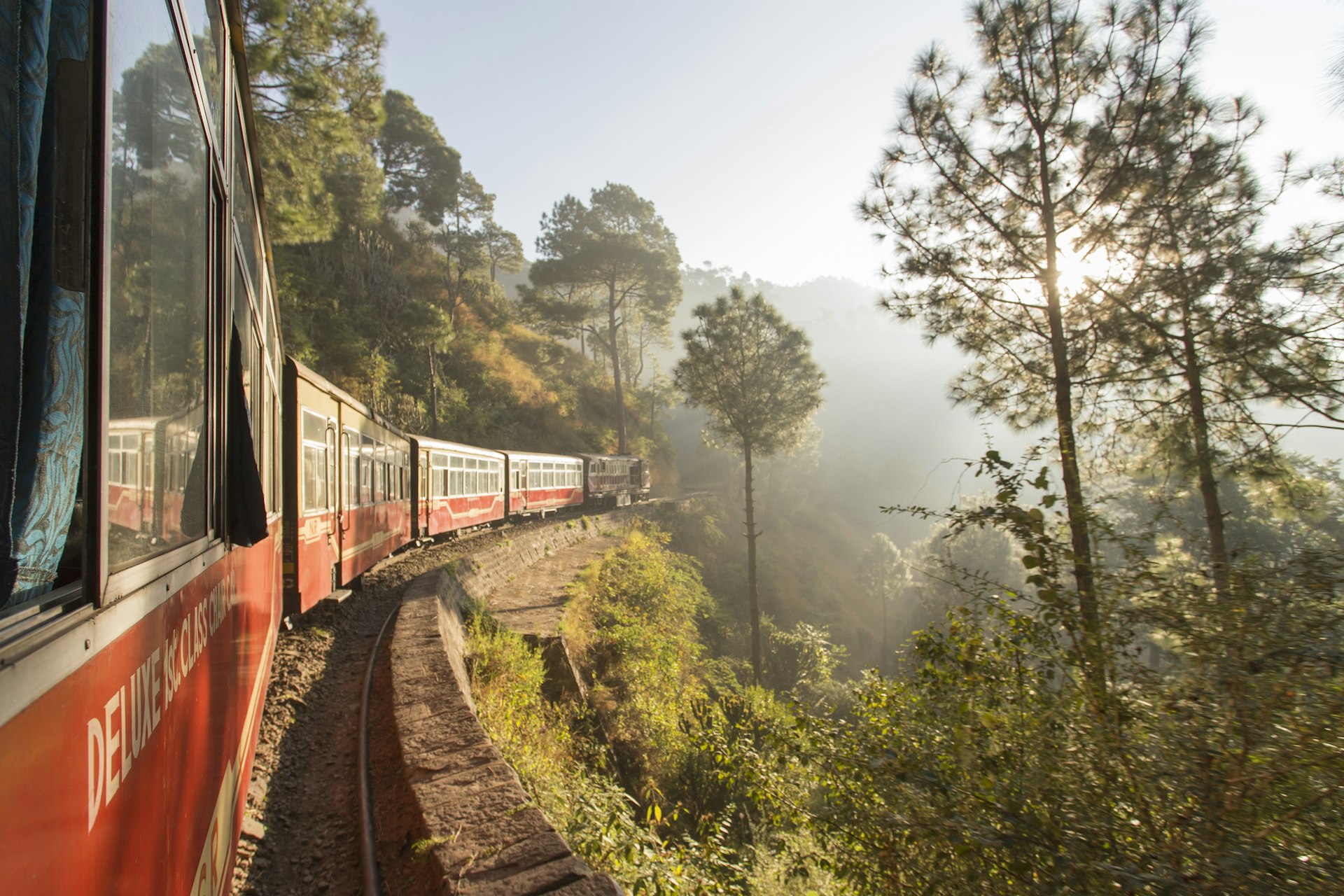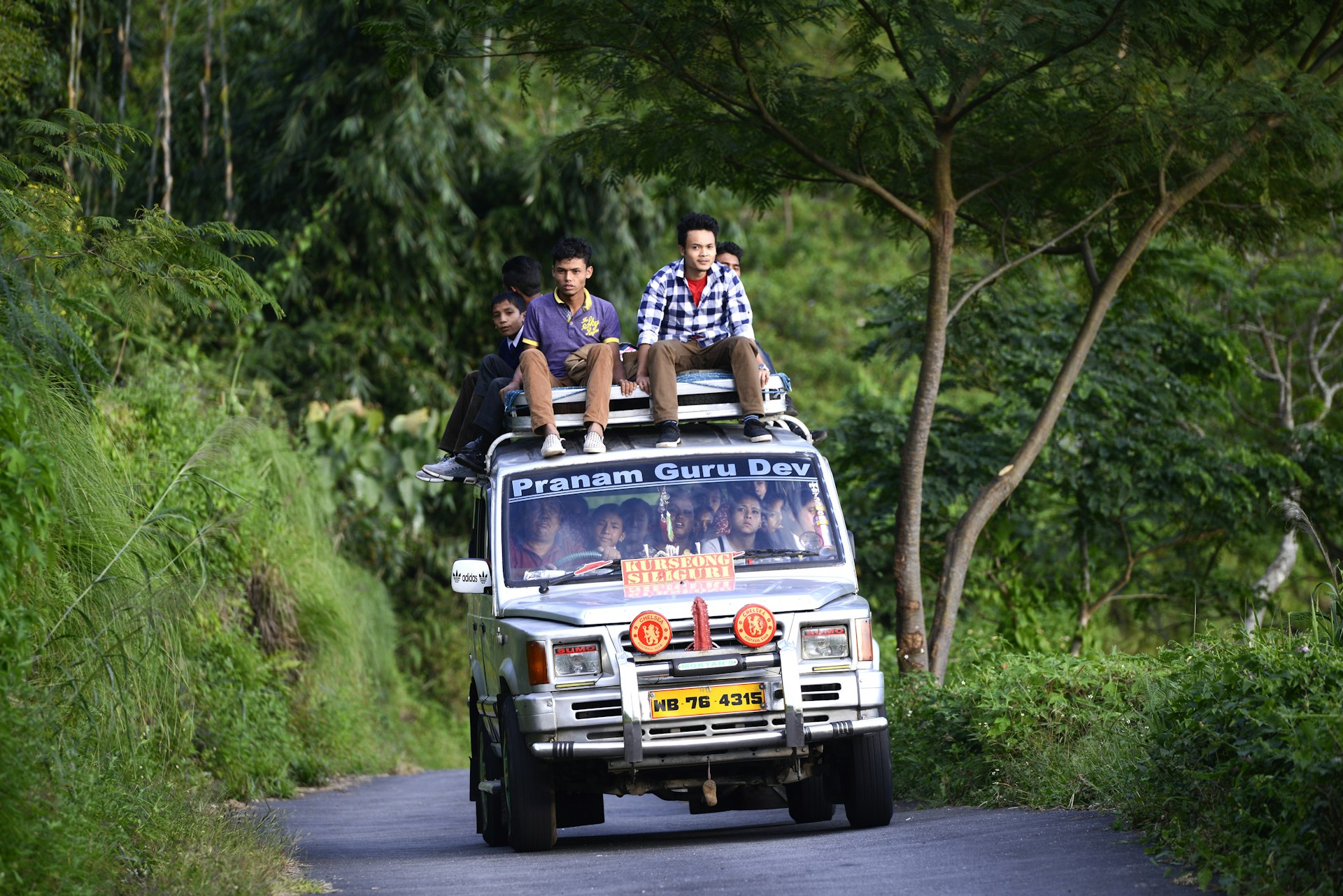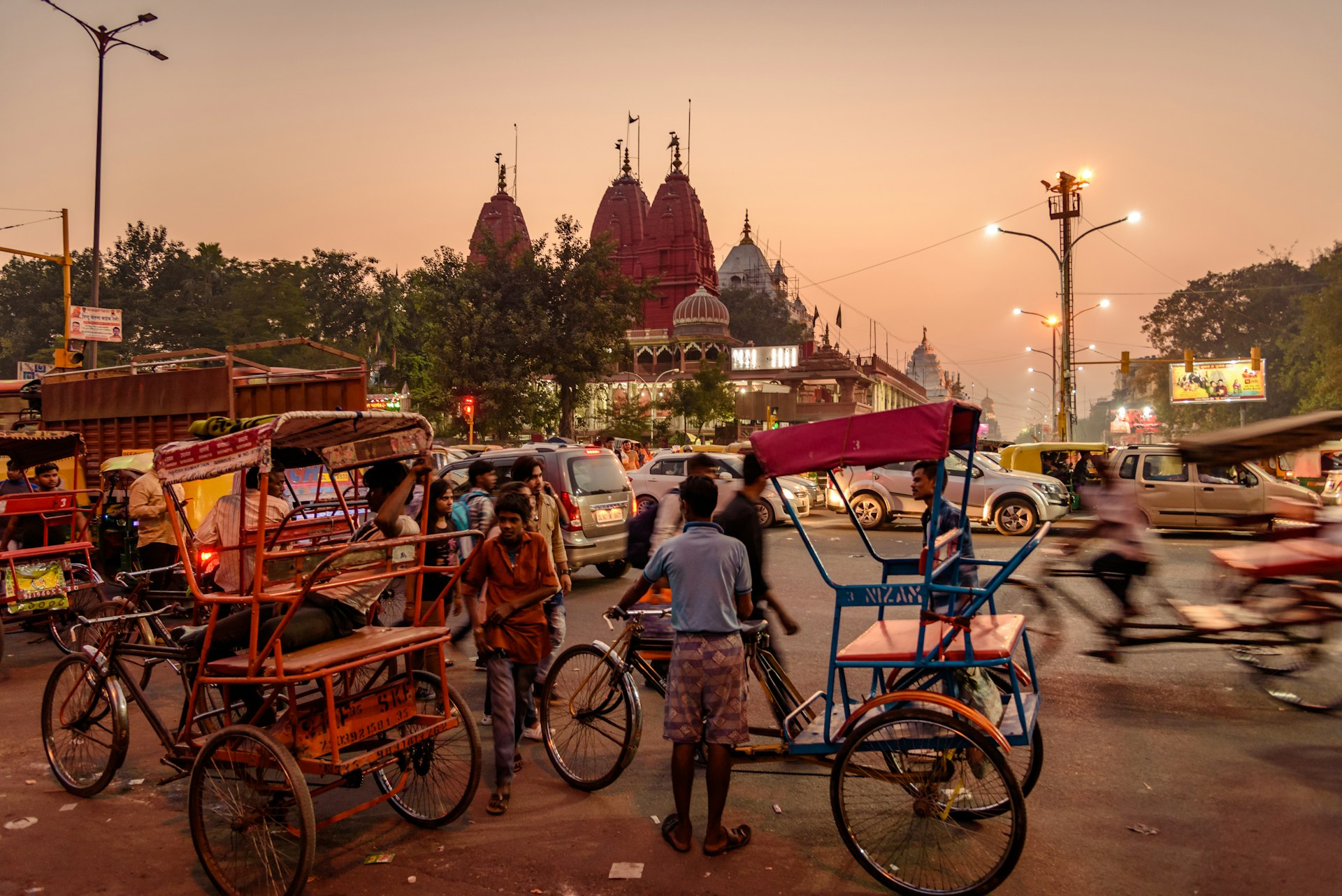
India is big the way continents are big. It’s a 3214km (2000-mile) journey from northern Ladakh to the tip of Tamil Nadu, and a 2933km (1822-mile) trip from the west end of Gujarat to Manipur in the Northeast States. Needless to say, getting from one end of this vast country to the other takes some time and effort.
Luckily, India’s magnificent rail network is on hand to do much of the heavy lifting, with nearly 20,000 trains running daily on 67,956km (42,226 miles) of track, carrying a staggering 8 billion passengers per year. Every journey by train is backed up by thousands of journeys by bus, jeep, taxi and rickshaw, while planes connect every corner of the country, from the beach resorts of Goa and Kerala to tiny mountain airstrips high in the Himalayas.
Whether you’re making plans for the plains or getting high in the hills, here’s our guide to getting around India.
Get more travel inspiration, tips and exclusive offers sent straight to your inbox with our weekly newsletter.  The best way to see India is by train: Shivalik Deluxe Express from Kalka to Shimla © Philip Lee Harvey / Lonely Planet
The best way to see India is by train: Shivalik Deluxe Express from Kalka to Shimla © Philip Lee Harvey / Lonely Planet
See India by train – there’s nothing like it!
Traveling by train in India is by far the most atmospheric way to explore the country, even with the visible lack of government investment in India’s vast but creaking rail network. Trains connect almost every corner of the country, including several charmingly nostalgic “toy trains” that run high into the foothills on narrow-gauge tracks.
Indian Railways operates the nation’s trains, which are identified by name and number, as well as by the category of service (express, passenger or mail). Express trains are best, as there are fewer stops at minor stations to slow things down. For fast journeys, seek out the Rajdhani Express trains that zip between India’s largest cities.
To book a train in India, you’ll need need to know both your desired train (by name and number) and stations. Many cities have multiple stations – often a city and cantonment stop, from the days when trains served British army barracks as well as downtown hubs – and some journeys involve connections in minor hubs that you’ll only visit for as long as it takes to jump from a train onto a bus.
There are many different classes – air-con 1st class (1AC) is the cream of the crop, with two or four-person berths featuring seats that convert into beds, compartments with lockable doors and food service to your seat. Two- and three-tier air-con carriages (2AC and 3AC) are almost as comfortable; sleeper carriages are similar to 3AC, only with fans instead of air-con. All are great for overnight trips, saving the cost of a hotel room for a night in relative comfort.
Unreserved 2nd class is a free-for-all – incredibly cheap, incredibly crowded and only really worth considering for short journeys in the countryside. For all reserved classes (sleeper and above) there are special quotas and waitlist booking systems that can get you a seat even when the train appears to be fully packed.
Tickets are best booked in advance, either at stations or online (via the government-run booking site IRCTC). The online booking process is complicated, however, and you’ll need an Indian-registered mobile phone SIM card to proceed. It’s usually easier to book through local booking sites such as 12Go, Cleartrip and Make My Trip.
Tips for train travel in India: When booking a trip, you’ll need to know the train number and the names (or codes) for the start and end stations. Consult the hard-copy booklet Trains at a Glance (available from station bookstands), or use the journey search engines on the Indian Railways website or Erail. The website Seat 61 is a treasure trove of information on Indian rail travel.
 On many local services, the bus won’t depart until every seat and every inch of space is filled © Dinodia Photo / Getty Images
On many local services, the bus won’t depart until every seat and every inch of space is filled © Dinodia Photo / Getty Images
Buses are the backbone of Indian travel
India has thousands of state-owned and private bus companies, and buses run almost everywhere at almost any time of day or night. Even if you can’t get where you want to go directly, there’ll often be a bus going halfway, with another bus completing the journey.
Unless there is no other choice, night buses are best avoided since drivers take advantage of the emptier roads to take even more death-defying risks than during daylight. On any mountain journey, avoid sitting over the wheels or behind the rear axle, unless you want to be tossed around like spaghetti.
Buses are super cheap. The price increases for various classes of “deluxe” buses (as compared to bone-shaking ordinary buses) and goes even higher for “Volvo” or “2×2” buses with airliner-style reclining seats. Private companies tend to charge slightly higher fares than government buses. Note that the duration of any journey will largely be dictated by the traffic in town at either end of the journey.
On many local services, the bus won’t be filled until every seat and every inch of space in the aisle is filled. Once you’re on board, remember to make your way toward the doors ahead of your stop to make sure you can disembark. Bags go under the bus or up on the roof (where you’ll be expected to deposit them yourself via a ladder on the back of the bus). Keep bags locked, and be watchful at food and toilet stops.
International buses run across India’s borders to Nepal, Bangladesh, Myanmar and Pakistan. State-run buses are usually reliable, but be wary of private “tourist buses” run by travel agencies: it’s not uncommon to be charged luxury bus fares for two local buses, one running either side of the border.
Tips for bus travel in India: There’s normally a scramble to get a seat when a bus pulls into the stop. One trick used by locals is to push a bag or coat through an open window to secure your place.
 Shared jeeps are particularly useful for reaching hill stations or the high valleys of the Himalayas © panoglobe / Shutterstock
Shared jeeps are particularly useful for reaching hill stations or the high valleys of the Himalayas © panoglobe / Shutterstock
Shared jeeps are the best way to explore the Himalayas
While buses travel deep into the mountains, you can also get around on an army of shared jeeps, from venerable, British-era Land Rovers to muscly local jeeps made by Tata and Maruti. Shared jeeps charge by the seat and typically leave when full (you can charter the whole jeep for an immediate departure).
Jeeps are more expensive than buses – but not by that much. And they’re particularly useful for reaching hill stations or the high valleys of the Himalayas, being able to squeeze around landslides and navigate dirt roads that are unsafe for buses because of flooding or snow.
Boat travel is more atmospheric than practical in India
Ferries run across many rivers in India, but point-to-point trips along rivers or the ocean seaboard are uncommon. The Angriya Cruise liner between Mumbai and Goa is one useful service, and infrequent sea ferries also run to Lakshadweep and the Andaman Islands.
There are also some wonderful luxury multi-day cruise services along some of India’s major rivers, including evocative trips on the Ganges and Brahmaputra Rivers with Assam Bengal Navigation. In rural areas, look for delightful cross-river trips by wooden rowboat or coracle (a small, basket-like vessel).
 Count on cycle rickshaws and auto-rickshaws to whisk you around any Indian city © JeJai Images / Shutterstock
Count on cycle rickshaws and auto-rickshaws to whisk you around any Indian city © JeJai Images / Shutterstock
Exploring India by air
Once upon a time, domestic air travel in India was a haphazard business, with unreliable schedules, aging state-owned aircraft and elevated US-dollar fares for non-Indian passengers. But since the liberalization of air travel in India in the 1990s, domestic aviation has exploded, with bargain fares for online booking and budget airlines bringing cheap air travel to the masses.
Given its environmental impact, many travelers are happy not to fly. Yet a short flight can be a good way to avoid overland travel through lawless regions, or save days of rough travel in ancient diesel jeeps that aren’t exactly paragons of safety or environmental friendliness themselves.
If you want to fly sparingly, save internal flights for trips into the Himalayas – the flights to Leh in Ladakh and Pakyong in Sikkim rank among the world’s most spectacular air routes, with dizzying views of the tallest mountains on earth. With rampant competition, airlines come and go in India; Air India, Indigo and SpiceJet are presently the biggest carriers.
 There’s been talk of regulated rickshaws around Old Delhi roads © Amit kg / Shutterstock
There’s been talk of regulated rickshaws around Old Delhi roads © Amit kg / Shutterstock
For a short trip in Indian cities, count on rickshaws and auto-rickshaws
Cycle rickshaws and auto-rickshaws – small motorized vehicles with a cab and room for two or three passengers plus the driver – are the most popular form of transport for short trips in any Indian town. Auto-rickshaws have meters, though drivers are often reluctant to use them. If you can’t get a metered ride, you’ll have to agree on a price with the driver at the start of the journey (unless you use the prepaid booking stands at major train stations and airports).
Taxis and rideshares are great for shorter distances
Taxis are found everywhere in India, and they can be hired for in-town rides, day trips and multi-day journeys. However, some taxis are only permitted to operate in certain areas, so don’t expect every cab to be able to take you across state lines. Supplementing conventional cabs, rideshares can be summoned via the Uber and Ola apps.
Officially, taxis should use the meter; drivers often refuse, so you’ll have to negotiate a fare before you set off. The taxis that loiter around tourist sites and train stations often overcharge, so flag down a moving cab to have a better chance of paying a fair rate. Prepaid taxi stands at major transport hubs offer cab rides at fixed prices.
Tips for long-distance taxi rides in India: Hiring a car and driver can be a great way to travel, particularly if you share the cost with a group. Drivers at taxi stands offer their services for half-day, full-day and multi-day trips. Seek out a driver who speaks good English; for multi-day trips, check that the price includes the drivers’ food and accommodation (drivers will make their own eating and sleeping arrangements).
Urban transport in India is cheap and frequent
Urban transport in India is provided by crowded city buses, taxis, rickshaws and auto-rickshaws, urban trains and – in some cities – clean, modern, air-conditioned metro systems. The metros in Delhi, Kolkata, Mumbai, Bengaluru, Hyderabad, Chennai and Kochi offer an easy way to explore these cities.



